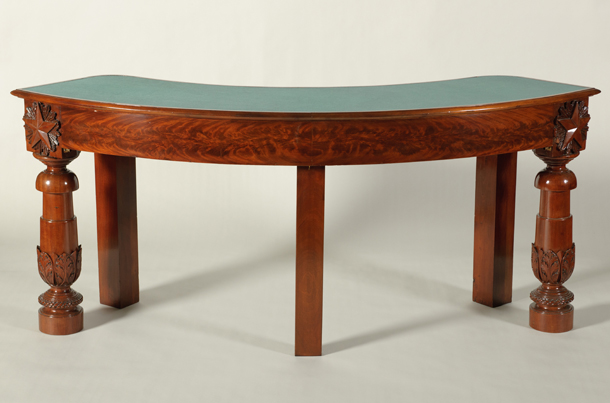
| Title | Desk, Vice President's |
| Artist/Maker | Thomas Constantine (attributed) |
| Date | 1819 ca. |
| Medium | Mahogany, wool |
| Dimensions | h. 31.13 x w. 75.38 x d. 25.50 in. (h. 79.1 x w. 191.5 x d. 64.8 cm) |
| Credit Line | U.S. Senate Collection |
| Accession Number | 65.00044.000 |
This mahogany desk was likely made by Thomas Constantine, a cabinetmaker from New York. Following the Capitol’s near destruction in 1814 by invading British forces, Constantine was paid for supplying the Senate with, among other items, one "Large Desk for President of Senate" as a cost of $140.
A similar style desk is depicted in engravings of the chamber that date as early as 1848. The desk was used by the Senate until 1859 when they vacated the room for their new chamber. Likely put into storage when the Supreme Court took over the space, the desk was later returned to the Senate in 1973 for the restoration of the historic room.
Thomas Constantine (1791–1849) was born in Derbyshire, England, and he and his family immigrated to New York City when he was two. Between 1806 and 1812, Constantine apprenticed with New York City cabinetmaker John Hewitt, and then served as a journeyman in the same shop between 1812 and 1814. Thomas opened his own cabinet shop in 1815, and in 1817 his firm, T. Constantine & Co., began competing with some of the city’s most notable furniture manufacturers.
Constantine received his most celebrated commissions as Congress prepared to reoccupy the U.S. Capitol after it had been damaged by fires set by British soldiers in August 1814. In 1818, Constantine received a contract to provide the House of Representatives Chamber with carpets, wall hangings, lamps, 192 chairs, and 51 tables. The following year, Constantine was awarded a contract to furnish the Senate Chamber with 48 mahogany armchairs and desks, as well as other furnishings, lighting, and textiles. Constantine’s brother, John (1796–1845) is known to have assisted with the upholstery of the chairs made for both chambers.
Although scholars consider Constantine’s work for the House and Senate to be the apex of his relatively brief career, T. Constantine & Co. produced furniture into the 1820s. He closed his furniture store in the summer of 1824 and furniture manufactory in 1826. Today furnishings by T. Constantine & Co. are represented in various collections, including the National Park Service, National Museum of American History, North Carolina Museum of History, U.S. House of Representatives, and Winterthur Museum.
For more information on Thomas Constantine, see Matthew A. Thurlow, “Aesthetics, Politics, and Power in Early-Nineteenth-Century Washington: Thomas Constantine & Co.’s Furniture for the United States Capitol, 1818-1819" in American Furniture (Chipstone Foundation, 2006).